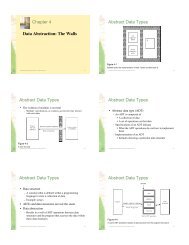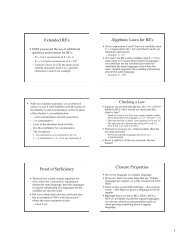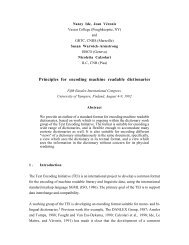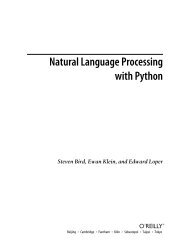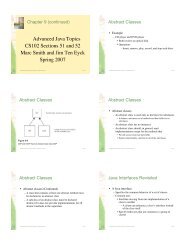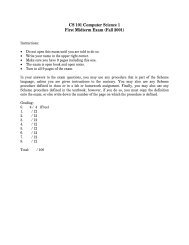From Text to Content: Computational Lexicons and the Semantic Web
From Text to Content: Computational Lexicons and the Semantic Web
From Text to Content: Computational Lexicons and the Semantic Web
Create successful ePaper yourself
Turn your PDF publications into a flip-book with our unique Google optimized e-Paper software.
<strong>From</strong> <strong>Text</strong> <strong>to</strong> <strong>Content</strong>: <strong>Computational</strong> <strong>Lexicons</strong> <strong>and</strong> <strong>the</strong> <strong>Semantic</strong> <strong>Web</strong><br />
Aless<strong>and</strong>ro Lenci 1 ,Nicoletta Calzolari 2 , An<strong>to</strong>nio Zampolli 1,2<br />
1 Università di Pisa, Dipartimen<strong>to</strong> di Linguistica<br />
via Santa Maria 36<br />
56127, Pisa, Italy<br />
aless<strong>and</strong>ro.lenci@ilc.cnr.it<br />
2 Istitu<strong>to</strong> di Linguistica Computazionale – CNR<br />
Area della Ricerca di Pisa, via Moruzzi 1<br />
56100, Pisa, Italy<br />
{glot<strong>to</strong>lo, pisa}@ilc.cnr.it<br />
Abstract<br />
The vision of <strong>the</strong> <strong>Semantic</strong> <strong>Web</strong> is <strong>to</strong> turn <strong>the</strong> World Wide<br />
<strong>Web</strong> in<strong>to</strong> a machine-underst<strong>and</strong>able knowledge base.<br />
According <strong>to</strong> this view, <strong>Web</strong> content is annotated with<br />
respect <strong>to</strong> particular on<strong>to</strong>logies, which provide <strong>the</strong> definition<br />
of <strong>the</strong> basic vocabulary <strong>and</strong> semantics of <strong>the</strong> annotations. In<br />
this paper we will argue that streng<strong>the</strong>ning <strong>the</strong> synergies<br />
between on<strong>to</strong>logy design <strong>and</strong> computational lexicon<br />
development is a key precondition for <strong>the</strong> <strong>Semantic</strong> <strong>Web</strong><br />
<strong>and</strong> HLT communities <strong>to</strong> truly benefit of each o<strong>the</strong>r’s<br />
results. In particular, we will tackle this issue by illustrating<br />
a series of requirements that computational lexicons must<br />
fulfill in order <strong>to</strong> become effective resources <strong>to</strong> contribute <strong>to</strong><br />
implement <strong>the</strong> <strong>Semantic</strong> <strong>Web</strong> vision. These requirements<br />
will be discussed in <strong>the</strong> context of an existing infrastructure<br />
for <strong>the</strong> development of semantic language resources.<br />
Finally, we will argue that <strong>the</strong> emerging st<strong>and</strong>ards for <strong>the</strong><br />
<strong>Semantic</strong> <strong>Web</strong> also provide <strong>the</strong> ground for <strong>the</strong> architecture<br />
<strong>and</strong> design of next-generation language resources.<br />
Introduction<br />
The vision of <strong>the</strong> <strong>Semantic</strong> <strong>Web</strong> is <strong>to</strong> turn <strong>the</strong> World Wide<br />
<strong>Web</strong> in<strong>to</strong> a machine-underst<strong>and</strong>able knowledge base,<br />
<strong>the</strong>reby allowing agents <strong>and</strong> applications <strong>to</strong> access a<br />
variety of heterogeneous resources by processing <strong>and</strong><br />
integrating <strong>the</strong>ir content. Nowadays, a sheer amount of <strong>the</strong><br />
information content available on <strong>the</strong> <strong>Web</strong> resides within<br />
natural language documents, only a part of which in<br />
English. Besides, a growing number of languages are<br />
enlarging <strong>the</strong>ir presence on <strong>the</strong> <strong>Web</strong>, with a relevant<br />
participation of Asian ones. Actually, this is a trend that is<br />
likely <strong>to</strong> continue, since making <strong>the</strong> <strong>Web</strong> a real global<br />
resource presupposes that users are granted <strong>the</strong> possibility<br />
<strong>to</strong> exchange information using <strong>the</strong>ir native <strong>to</strong>ngue.<br />
In order <strong>to</strong> make <strong>the</strong> <strong>Semantic</strong> <strong>Web</strong> a reality, it is<br />
<strong>the</strong>refore necessary <strong>to</strong> tackle <strong>the</strong> twofold challenge of<br />
content availability <strong>and</strong> multilinguality (Benjamins et al.<br />
2002). This in turn implies fostering <strong>the</strong> way information<br />
in natural language documents is identified, extracted <strong>and</strong><br />
explicitly represented in a such a way <strong>to</strong> become accessible<br />
by software agents. A natural convergence thus exists<br />
between <strong>the</strong> <strong>Semantic</strong> <strong>Web</strong> long-term goals <strong>and</strong> some of<br />
<strong>the</strong> core activities in <strong>the</strong> field of Human Language<br />
Technology (HLT). Multilingual semantic processing<br />
actually lies at <strong>the</strong> heart of Natural Language Processing<br />
(NLP) <strong>and</strong> Language Engineering (LE) research <strong>and</strong><br />
technological development, since no effective text<br />
underst<strong>and</strong>ing can be envisaged without <strong>the</strong> proper<br />
identification <strong>and</strong> representation of <strong>the</strong> semantic content of<br />
documents encoded in different languages.<br />
In <strong>the</strong> <strong>Semantic</strong> <strong>Web</strong>, content is annotated with respect<br />
<strong>to</strong> particular on<strong>to</strong>logies, which provide <strong>the</strong> definition of <strong>the</strong><br />
basic vocabulary <strong>and</strong> semantics of <strong>the</strong> annotations. More in<br />
general, on<strong>to</strong>logies appear as key ingredients in knowledge<br />
management <strong>and</strong> content based systems, with applications<br />
ranging from document search <strong>and</strong> categorization, e-<br />
commerce, agent-<strong>to</strong>-agent communication, etc. In HLT, <strong>the</strong><br />
task of providing <strong>the</strong> basic semantic description of words is<br />
entrusted <strong>to</strong> computational lexicons, which <strong>the</strong>refore<br />
represent critical information sources for most NLP<br />
systems. The availability of large-scale reposi<strong>to</strong>ries of<br />
lexical information is in fact an essential precondition for<br />
HLT <strong>to</strong> be able <strong>to</strong> tackle <strong>the</strong> full complexity of<br />
multilingual text processing.<br />
On<strong>to</strong>logies also represent an important bridge between<br />
knowledge representation <strong>and</strong> computational lexical<br />
semantics, <strong>and</strong> actually form a continuum with semantic<br />
lexicons. In fact, <strong>the</strong>y are widely used (<strong>to</strong>ge<strong>the</strong>r with<br />
lexicons) <strong>to</strong> represent <strong>the</strong> lexical content of words, <strong>and</strong><br />
appear <strong>to</strong> have a crucial role in different natural language<br />
processing (NLP) tasks, such as content-based tagging,<br />
word sense disambiguation, multilingual transfer, etc.
Besides, one of <strong>the</strong> most widely used lexical resources,<br />
WordNet (Fellbaum 1998), is also commonly regarded <strong>and</strong><br />
used as an on<strong>to</strong>logy, as fur<strong>the</strong>r evidence of <strong>the</strong><br />
commonalities existing between computational lexicons<br />
<strong>and</strong> on<strong>to</strong>logies (Guarino 1998, Oltramari et al. 2002).<br />
The main argument of this paper is that streng<strong>the</strong>ning<br />
<strong>the</strong> synergies between on<strong>to</strong>logy design <strong>and</strong> computational<br />
lexicon development is a key precondition for <strong>the</strong><br />
<strong>Semantic</strong> <strong>Web</strong> <strong>and</strong> HLT communities <strong>to</strong> truly benefit of<br />
each o<strong>the</strong>r’s results. In particular, we will tackle this issue<br />
by illustrating a series of requirements that computational<br />
lexicons must fulfill in order <strong>to</strong> become effective resources<br />
<strong>to</strong> contribute <strong>to</strong> implement <strong>the</strong> <strong>Semantic</strong> <strong>Web</strong> vision. These<br />
requirements will be discussed in <strong>the</strong> context of an existing<br />
infrastructure for <strong>the</strong> development of semantic language<br />
resources. Moreover, we will also argue for a bidirectional<br />
interaction between computational lexicons <strong>and</strong><br />
<strong>the</strong> <strong>Semantic</strong> <strong>Web</strong>. Not only will computational lexicons<br />
contribute <strong>to</strong> <strong>the</strong> content-based management of information<br />
on <strong>the</strong> <strong>Web</strong>, but <strong>the</strong> emerging st<strong>and</strong>ards for <strong>the</strong> <strong>Semantic</strong><br />
<strong>Web</strong> also provide <strong>the</strong> ground for <strong>the</strong> architecture <strong>and</strong><br />
design of next-generation language resources.<br />
A General Infrastructure for Multilingual<br />
<strong>Computational</strong> <strong>Lexicons</strong><br />
<strong>Computational</strong> lexicons aim at making word content<br />
machine-underst<strong>and</strong>able. That is <strong>to</strong> say, <strong>the</strong>y intend <strong>to</strong><br />
provide an explicit representation of word meaning, so that<br />
it can be directly accessed <strong>and</strong> used by computational<br />
agents, such as a large-coverage parser, a module for<br />
intelligent Information Retrieval or Information Extraction,<br />
etc. In all <strong>the</strong>se cases, semantic information is necessary <strong>to</strong><br />
enhance <strong>the</strong> performance of NLP <strong>to</strong>ols, <strong>and</strong> <strong>to</strong> achieve a<br />
real underst<strong>and</strong>ing of text content. Multilingual<br />
computational lexicons add <strong>to</strong> <strong>the</strong> representation of word<br />
meaning <strong>the</strong> information necessary <strong>to</strong> establish links<br />
among words of different natural languages, <strong>and</strong> are key<br />
components in systems for multilingual text processing,<br />
such as Machine Translation, Cross-lingual Information<br />
Retrieval, etc.<br />
In <strong>the</strong> last decade, many activities have contributed <strong>to</strong><br />
substantially advance knowledge <strong>and</strong> capability of how <strong>to</strong><br />
represent, create, maintain, acquire, access, etc. large<br />
lexical reposi<strong>to</strong>ries. These reposi<strong>to</strong>ries are rich in linguistic<br />
knowledge, <strong>and</strong> based on best practices <strong>and</strong> st<strong>and</strong>ards that<br />
have been consensually agreed on or have been submitted<br />
<strong>to</strong> <strong>the</strong> international community as de fac<strong>to</strong> st<strong>and</strong>ards. Core<br />
- or even large - lexical reposi<strong>to</strong>ries have been <strong>and</strong> are<br />
being built for many languages. Besides WordNet,<br />
important examples are EuroWordNet (Vossen 1998),<br />
PAROLE (Ruimy et al. 1998), SIMPLE (Lenci et al.<br />
2000a) in Europe, ComLex (Grishman, Macleod <strong>and</strong><br />
Meyers 1994), FrameNet (Fillmore, Wooters <strong>and</strong> Baker<br />
2001) in <strong>the</strong> US, among many o<strong>the</strong>rs.<br />
A fur<strong>the</strong>r step <strong>and</strong> radical change of perspective is now<br />
needed in order <strong>to</strong> facilitate <strong>the</strong> integration of <strong>the</strong> linguistic<br />
information resulting from all <strong>the</strong>se initiatives, <strong>to</strong> bridge<br />
<strong>the</strong> differences between various perspectives on language<br />
structure <strong>and</strong> linguistic content, <strong>to</strong> put an infrastructure in<strong>to</strong><br />
place for content description at <strong>the</strong> international level, <strong>and</strong><br />
<strong>to</strong> make lexical resources usable within <strong>the</strong> emerging<br />
<strong>Semantic</strong> <strong>Web</strong> scenario. This objective can only be<br />
achieved when working in <strong>the</strong> direction of an integrated<br />
open <strong>and</strong> distributed lexical infrastructure, which is able <strong>to</strong><br />
simultaneously tackle <strong>the</strong> following aspects:<br />
i. <strong>to</strong> foster <strong>the</strong> design of advanced architectures for <strong>the</strong><br />
representation of lexical content;<br />
ii.<br />
<strong>to</strong> develop new methods <strong>and</strong> techniques for <strong>the</strong><br />
au<strong>to</strong>matic acquisition of semantic knowledge from<br />
texts <strong>and</strong> for <strong>the</strong> cus<strong>to</strong>mization <strong>and</strong> update of lexical<br />
resources;<br />
iii. <strong>to</strong> promote <strong>the</strong> st<strong>and</strong>ardization of various aspects of<br />
<strong>the</strong> lexicon, up <strong>to</strong> content interoperability st<strong>and</strong>ards.<br />
In <strong>the</strong> sections below, we will address <strong>the</strong>se points by<br />
presenting a general infrastructure for <strong>the</strong> development of<br />
semantic language resources whose main objective is <strong>to</strong><br />
tackle <strong>the</strong> issues above in an innovative way.<br />
Lexicon Modelling<br />
According <strong>to</strong> a widely quoted definition (Gruber 1993),<br />
<strong>the</strong> term on<strong>to</strong>logy refers <strong>to</strong> “a specification of a<br />
conceptualization”, that is <strong>to</strong> say <strong>the</strong> description of “<strong>the</strong><br />
concepts <strong>and</strong> relationships that can exist for an agent or a<br />
community of agents”. An alternative <strong>and</strong> yet similar<br />
definition conceives an on<strong>to</strong>logy as “a set of knowledge<br />
terms, including <strong>the</strong> vocabulary, <strong>the</strong> semantic<br />
interconnections <strong>and</strong> some simple rules of inference <strong>and</strong><br />
logic, for some particular <strong>to</strong>pic” (Hendler 2001).<br />
Prima facie, a striking similarity exists between<br />
on<strong>to</strong>logies <strong>and</strong> computational semantic lexicons. In both<br />
cases, <strong>the</strong> goal is <strong>to</strong> carve out <strong>the</strong> shape of a particular<br />
portion of semantic space, by individuating <strong>the</strong> relevant<br />
basic elements (i.e. <strong>the</strong> concept expressed by terms or<br />
words) <strong>and</strong> <strong>the</strong> <strong>to</strong>pology of relations holding among <strong>the</strong>m.<br />
Actually, in computational lexical semantics on<strong>to</strong>logies are<br />
also widely used as a formal apparatus <strong>to</strong> characterize<br />
lexical content. That is <strong>to</strong> say, a set of general concepts is<br />
selected as <strong>the</strong> core reposi<strong>to</strong>ry of semantic types <strong>to</strong> classify<br />
<strong>and</strong> describe <strong>the</strong> semantic content of lexical items. This is<br />
for instance <strong>the</strong> case of <strong>the</strong> EuroWordNet Top On<strong>to</strong>logy<br />
(Rodriguez et al. 1998), which is used <strong>to</strong> describe <strong>the</strong> basic<br />
concepts of <strong>the</strong> lexical database, <strong>and</strong> <strong>the</strong> SIMPLE Core<br />
On<strong>to</strong>logy, providing <strong>the</strong> main type system <strong>to</strong> classify word<br />
senses (Lenci et al. 2000b).
Commonalities should however not overshadow <strong>the</strong><br />
differences between on<strong>to</strong>logies <strong>and</strong> computational<br />
lexicons, nor blur <strong>the</strong> specific character of <strong>the</strong> challenge set<br />
by lexical meaning description. Differences mainly reside<br />
in <strong>the</strong> peculiar character of lexical knowledge, which<br />
computational lexicons purports at describing. Some of <strong>the</strong><br />
main features of <strong>the</strong> latter can be described as follows:<br />
1. lexical knowledge is inherently heterogeneous <strong>and</strong><br />
implicitly structured. For instance, describing <strong>the</strong><br />
semantic content of words like part, material, link, etc.<br />
necessarily implies <strong>to</strong> refer <strong>to</strong> <strong>the</strong>ir inherent relational<br />
nature. Verbs also require specific representational<br />
solutions, often quite different from <strong>the</strong> ones adopted<br />
for nouns (cf. Busa et al. 2001). In fact, <strong>the</strong><br />
specification of <strong>the</strong> number <strong>and</strong> types of participants<br />
<strong>to</strong> <strong>the</strong> event express by <strong>the</strong> verb or <strong>the</strong> temporal<br />
properties of <strong>the</strong> event itself are crucial conditions for<br />
a satisfac<strong>to</strong>ry description of its meaning. Moreover,<br />
word meaning is always <strong>the</strong> product of complex<br />
dynamics: what appear in a computational lexicon<br />
must be regarded as <strong>the</strong> result of an abstraction<br />
process from <strong>the</strong> concrete <strong>and</strong> multifaceted behavior<br />
of words in texts, which in turn appear <strong>to</strong> keep on reshaping<br />
its organization.<br />
2. polysemy is a widespread <strong>and</strong> pervasive feature<br />
affecting <strong>the</strong> organization of <strong>the</strong> lexicon. The different<br />
senses of a word are only rarely separate <strong>and</strong> welldistinguished<br />
conceptual units. In a much more<br />
common situation, words have multiple meanings that<br />
are in turn deeply interwoven, <strong>and</strong> can also be<br />
simultaneously activated in <strong>the</strong> same context. Bank is<br />
usually quoted as a clear case of ambiguity between a<br />
location near a river, <strong>and</strong> a financial institution. The<br />
problem is that even in this case, <strong>the</strong> latter sense of<br />
bank is actually a constellation of different meanings:<br />
<strong>the</strong> bank-as-institution needs <strong>to</strong> be distinguished from<br />
<strong>the</strong> bank-as-a-building, <strong>and</strong> yet <strong>the</strong>se two senses are<br />
clearly related in a way in which <strong>the</strong> bank of <strong>the</strong><br />
Thames river <strong>and</strong> <strong>the</strong> Bank of Engl<strong>and</strong> are not.<br />
3. related <strong>to</strong> <strong>the</strong> former point, it is necessary <strong>to</strong> tackle <strong>the</strong><br />
central issue that word senses are multidimensional<br />
entities that can barely be analyzed in terms of unique<br />
assignments <strong>to</strong> points in a system of concepts. As<br />
particularly argued in Pustejovsky (1995), a suitable<br />
type system for lexical representation must be<br />
provided with an unprecedented complexity of<br />
architectural design, exactly <strong>to</strong> take in<strong>to</strong> account <strong>the</strong><br />
protean nature of lexicon <strong>and</strong> its multifaceted<br />
behavior.<br />
In <strong>the</strong> last years, <strong>the</strong> community of language resource<br />
developers is becoming aware that <strong>the</strong>se issues represent<br />
essential constraints for computational lexicon design.<br />
Ignoring <strong>the</strong>m or dismissing <strong>the</strong>m as being purely<br />
<strong>the</strong>oretical points would end up blurring <strong>the</strong> specificity of<br />
lexical knowledge, with an negative impact on <strong>the</strong>ir<br />
practical usability in applications.<br />
The need <strong>to</strong> account for <strong>the</strong> multidimensional nature of<br />
linguistic data requires <strong>the</strong> development of richer systems<br />
of semantic types, where <strong>the</strong> conceptualization expressed<br />
by word meanings must be analyzed along various<br />
orthogonal dimensions. The relational aspects of lexical<br />
items, <strong>the</strong> argument structures of predicative expressions,<br />
<strong>and</strong> <strong>the</strong> complex interplay of syntactic <strong>and</strong> semantic<br />
conditions must necessarily find a proper place within<br />
lexical architectures. Besides, <strong>the</strong> notion itself of lexical<br />
unit is not without problems, given <strong>the</strong> pervasive presence<br />
of non-compositional aspects in <strong>the</strong> lexicon, such as<br />
collocations, multiword expressions, idioms, etc. As a<br />
result, a suitable lexical architecture must necessarily<br />
provide a “hybrid environment”, where <strong>the</strong> semantic<br />
content is represented through a careful <strong>and</strong> variously<br />
weighted combination of different types of formal entities.<br />
An attempt <strong>to</strong> adhere <strong>to</strong> <strong>the</strong> above constraints <strong>and</strong> <strong>to</strong><br />
meet <strong>the</strong> complexity of lexical content processing is<br />
represented by <strong>the</strong> SIMPLE model (Lenci et al. 2000b).<br />
This provides a system of semantic types for multilingual<br />
lexical encoding in which <strong>the</strong> multidimensionality of word<br />
meaning is explicitly targeted. Different aspects of <strong>the</strong><br />
linguistic behavior of lexical items - ranging from semantic<br />
relations, <strong>to</strong> argument structure <strong>and</strong> aspect – ground <strong>the</strong><br />
structural organization of <strong>the</strong> SIMPLE on<strong>to</strong>logy. Actually,<br />
<strong>the</strong> approach specifically adopted in SIMPLE offers some<br />
relevant answers <strong>to</strong> <strong>the</strong> problems of on<strong>to</strong>logy design for <strong>the</strong><br />
lexicon, <strong>and</strong> at <strong>the</strong> same time brings <strong>to</strong> <strong>the</strong> surface o<strong>the</strong>r<br />
crucial issues related <strong>to</strong> <strong>the</strong> representation of lexical<br />
knowledge aiming at <strong>the</strong> development of computational<br />
lexical reposi<strong>to</strong>ries.<br />
The design of <strong>the</strong> SIMPLE model complies with <strong>the</strong><br />
EAGLES Lexicon/<strong>Semantic</strong>s Working Group guidelines<br />
<strong>and</strong> <strong>the</strong> set of recommended semantic notions. The model<br />
has been instantiated in semantic lexicons of about 10,000<br />
senses covering 12 languages (Catalan, Danish, Dutch,<br />
English, Finnish, French, German, Greek, Italian,<br />
Portuguese, Spanish, Swedish). Each lexicon encodes<br />
structured “semantic types” <strong>and</strong> semantic<br />
(subcategorization) frames, which are linked <strong>to</strong> <strong>the</strong><br />
syntactic entries in <strong>the</strong> LE-PAROLE lexicon, <strong>the</strong>reby<br />
granting an optimal integration between semantic <strong>and</strong><br />
syntactic lexical information.<br />
The SIMPLE model provides <strong>the</strong> formal specification<br />
for <strong>the</strong> representation <strong>and</strong> encoding of <strong>the</strong> following<br />
information:<br />
− semantic type;<br />
− domain information;<br />
− lexicographic gloss;<br />
− argument structure for predicative lexical items;
− selectional restrictions on <strong>the</strong> arguments;<br />
− event type, <strong>to</strong> characterise <strong>the</strong> aspectual properties of<br />
verbal predicates;<br />
− links of <strong>the</strong> arguments <strong>to</strong> <strong>the</strong> syntactic<br />
subcategorization frames, as represented in <strong>the</strong> LE-<br />
PAROLE lexicons;<br />
− ‘qualia’ structure, as specified in <strong>the</strong> Generative<br />
Lexicon (Pustejovsky, 1995);<br />
− information about regular polysemous alternation in<br />
which a word-sense may enter;<br />
− information concerning cross-part of speech relations<br />
(e.g. intelligent - intelligence; writer - <strong>to</strong> write).<br />
− semantic relations, such as hyponymy, synonymy, etc.<br />
The “conceptual core” of <strong>the</strong> lexicons consists of <strong>the</strong><br />
basic structured set of semantic types <strong>and</strong> <strong>the</strong> basic set of<br />
notions <strong>to</strong> be encoded for each sense. These notions have<br />
been captured in a common “library” of language<br />
independent templates, which act as “blueprints” for any<br />
given type - reflecting well-formedness conditions <strong>and</strong><br />
providing constraints for lexical items belonging <strong>to</strong> that<br />
type.<br />
The semantic types form <strong>the</strong> SIMPLE Core On<strong>to</strong>logy<br />
(fig. 1) The principles of Qualia Structure have also been<br />
adopted <strong>to</strong> design <strong>the</strong> <strong>to</strong>p-level on<strong>to</strong>logy according <strong>to</strong> an<br />
orthogonal organisation of semantic types (Pustejovsky<br />
<strong>and</strong> Boguraev 1993; Pustejovsky 1995). In fact, <strong>the</strong> idea of<br />
orthogonal architectures represent an important<br />
contribution coming from <strong>the</strong> Generative Lexicon <strong>to</strong><br />
overcome <strong>the</strong> limitations of conventional type systems,<br />
which are structured in a purely taxonomical way.<br />
Orthogonally structured on<strong>to</strong>logies essentially enrich <strong>the</strong><br />
conventional architecture by organising <strong>the</strong> semantic types<br />
along multiple dimensions, which are given minimally by<br />
<strong>the</strong> Qualia roles.<br />
1. TELIC [Top]<br />
…<br />
2. AGENTIVE [Top]<br />
2.1. Cause [Agentive]<br />
…<br />
3. CONSTITUTIVE [Top]<br />
3.1. Part [Constitutive]<br />
3.1.1. Body_part [Part]<br />
3.2. Group [Constitutive]<br />
3.2.1. Human_group [Group]<br />
3.3. Amount [Constitutive]<br />
…<br />
4. ENTITY [Top]<br />
4.1. Concrete_entity [Entity]<br />
4.1.1. Location [Concrete_entity] …<br />
Figure 1: A sample of <strong>the</strong> SIMPLE Core On<strong>to</strong>logy.<br />
In SIMPLE word-senses are encoded as <strong>Semantic</strong> Units<br />
or SemU. Each SemU is assigned a semantic type from <strong>the</strong><br />
On<strong>to</strong>logy, plus o<strong>the</strong>r sorts of information specified in <strong>the</strong><br />
associated template, which contribute <strong>to</strong> <strong>the</strong><br />
characterization of <strong>the</strong> word-sense. We report below a<br />
schematic representation of two lexical entries<br />
(respectively for <strong>the</strong> noun violin <strong>and</strong> <strong>the</strong> verb <strong>to</strong> look),<br />
encoded according <strong>to</strong> <strong>the</strong> SIMPLE specifications:<br />
LEMMA:<br />
violin<br />
SEMU_ID:<br />
violin_1<br />
POS:<br />
N<br />
GLOSS: a type of musical<br />
instrument<br />
DOMAIN:<br />
music<br />
SEMANTIC_TYPE: instrument<br />
FORMAL_ROLE: isa musical-instrument<br />
CONSTITUTIVE_ROLE: has_as_part string<br />
made_of wood<br />
TELIC_ROLE:<br />
used_by violinist<br />
used_for play<br />
LEMMA:<br />
look<br />
SEMU_ID:<br />
look_1<br />
POS:<br />
V<br />
GLOSS:<br />
intentionally<br />
perceiving something<br />
with eyes<br />
SEMANTIC_TYPE: perception<br />
EVENT_TYPE<br />
process<br />
FORMAL_ROLE:<br />
isa perceive<br />
CONSTITUTIVE_ROLE: instrument eye<br />
intentionality = yes<br />
PRED_REPRESENTATION: look (Arg0: animate)<br />
(Arg1: entity)<br />
SYN_SEM_LINKING: Arg0 = subj_NP<br />
Arg1 = obl_PP_at<br />
The full expressive power of <strong>the</strong> SIMPLE model is<br />
given by a wide set of features <strong>and</strong> relations, which are<br />
organized along <strong>the</strong> four Qualia dimensions proposed in<br />
<strong>the</strong> Generative Lexicon as <strong>the</strong> main axes of lexical<br />
description, i.e. Formal Role, Constitutive Role, Agentive<br />
Role <strong>and</strong> Telic Role. Features are introduced <strong>to</strong><br />
characterize those attributes for which a closed <strong>and</strong><br />
restricted range of values can be specified (e.g. sex={male,<br />
female}, intentionality={yes, no}, etc.). On <strong>the</strong> o<strong>the</strong>r h<strong>and</strong>,<br />
relations connect a given SemU <strong>to</strong> o<strong>the</strong>r semantic units.<br />
They are used <strong>to</strong> capture multiple aspects of word<br />
meaning, ranging from functionality (e.g. used_for,<br />
used_by), <strong>to</strong> mode of creation (e.g. derived_from,<br />
created_by) <strong>and</strong> internal constitution (e.g. has_as_part,<br />
made_of, etc.). Relations are organized along taxonomic
wing<br />
created_by<br />
<br />
used_for<br />
<br />
SemU_1<br />
Type: [part]<br />
part of an airplane<br />
is_a_part_of<br />
isa<br />
<br />
SemU_2<br />
Type: [part]<br />
part of a building<br />
SemU_3<br />
Type: [part]<br />
organ of birds for flying<br />
isa<br />
<br />
isa<br />
is_a_part_of<br />
is_a_part_of<br />
<br />
used_for<br />
<br />
Figure 2: A semantic representation of wing<br />
hierarchies, allowing for <strong>the</strong> possibility of<br />
underspecification, as well as <strong>the</strong> introduction of more<br />
refined subtypes of a given relation. Features <strong>and</strong> relations<br />
are also used <strong>to</strong> capture aspects of world knowledge<br />
relevant <strong>to</strong> characterize <strong>the</strong> semantic behavior of words.<br />
Lexical representations can thus be turned in<strong>to</strong> a core<br />
inference layer licensed by words.<br />
In SIMPLE, it is possible <strong>to</strong> capture <strong>the</strong> different<br />
semantic load of various classes of word senses, by<br />
calibrating <strong>the</strong> usage of <strong>the</strong> different pieces <strong>and</strong> types<br />
ofinformation made available by <strong>the</strong> model. For instance,<br />
figure 2 shows a possible characterization of a portion of<br />
<strong>the</strong> semantic space associated <strong>to</strong> <strong>the</strong> word wing. This<br />
content can be partitioned in three SemUs, that share <strong>the</strong><br />
same semantic type (actually <strong>the</strong>y are all parts), but can be<br />
never<strong>the</strong>less distinguished in terms of <strong>the</strong> relations <strong>the</strong>y<br />
entertain with o<strong>the</strong>r semantic units. Thus, if on <strong>the</strong> one<br />
h<strong>and</strong> SemU_1 <strong>and</strong> SemU_3 are alike with respect <strong>to</strong> <strong>the</strong><br />
functionality dimension (<strong>the</strong>y both refer <strong>to</strong> entities used for<br />
flying), <strong>the</strong>y are set apart under <strong>the</strong> constitutive aspects,<br />
since SemU_1 refers <strong>to</strong> a part of an airplane while <strong>the</strong><br />
SemU_3 <strong>to</strong> a part of a bird., etc.<br />
Although we are still far aside form being able <strong>to</strong><br />
provide really satisfac<strong>to</strong>ry representations of word content,<br />
<strong>the</strong> SIMPLE architecture tries <strong>to</strong> approximate natural<br />
language complexity by providing a highly expressive <strong>and</strong><br />
versatile model for language content description. The idea<br />
of a <strong>Semantic</strong> <strong>Web</strong> actually makes <strong>the</strong> underst<strong>and</strong>ing <strong>and</strong><br />
modeling of <strong>the</strong> “lexical web” even more crucial, as <strong>the</strong><br />
essential precondition for an effective natural language<br />
content processing.<br />
Lexicon bootstrap <strong>and</strong> acquisition<br />
The continuously changing dem<strong>and</strong>s for languagespecific<br />
<strong>and</strong> application-dependent annotated data (e.g. at<br />
<strong>the</strong> syntactic or at <strong>the</strong> semantic level), indispensable for<br />
design validation <strong>and</strong> efficient software pro<strong>to</strong>typing,<br />
however, are daily confronted by <strong>the</strong> resource bottleneck.<br />
H<strong>and</strong>crafted resources are often <strong>to</strong>o costly <strong>and</strong> timeconsuming<br />
<strong>to</strong> be produced at a sustainable pace, <strong>and</strong>, in<br />
some cases, <strong>the</strong>y even exceed <strong>the</strong> limits of human<br />
conscious awareness <strong>and</strong> descriptive capability. The<br />
problem is even more acutely felt for low-resource<br />
languages, since <strong>the</strong> early stages of language resource<br />
development often require ga<strong>the</strong>ring considerable<br />
momentum both in terms of know-how <strong>and</strong> level of<br />
funding, of <strong>the</strong> order of magnitude normally deployed by<br />
large national projects.<br />
Secondly, computational lexicons should be ra<strong>the</strong>r<br />
conceived as dynamic systems, whose development needs<br />
<strong>to</strong> be complemented with <strong>the</strong> au<strong>to</strong>matic acquisition of<br />
semantic information from texts. In fact, semantic lexical<br />
content can not be identified only through a <strong>to</strong>p-down<br />
process, nor can lexical items be conceived as entities in<br />
isolation. Since conversely meanings live <strong>and</strong> arise in<br />
linguistic contexts, it is necessary <strong>to</strong> take in<strong>to</strong> account how<br />
semantic information emerges from <strong>the</strong> actual textual data,<br />
<strong>and</strong> how <strong>the</strong> latter contribute <strong>to</strong> meaning formation <strong>and</strong><br />
change. Consistently, computational lexicons are not fixed<br />
reposi<strong>to</strong>ries of semantic descriptions, but ra<strong>the</strong>r provide<br />
core set of meanings that need <strong>to</strong> be cus<strong>to</strong>mized <strong>and</strong><br />
adapted <strong>to</strong> different domains, applications, texts, etc. This
seems <strong>to</strong> be an essential condition for language resources<br />
<strong>to</strong> be really suited <strong>to</strong> process <strong>the</strong> semantic content of<br />
documents.<br />
Possible ways <strong>to</strong> circumvent, or at least minimize, <strong>the</strong>se<br />
problems come from <strong>the</strong> literature on au<strong>to</strong>matic knowledge<br />
acquisition <strong>and</strong>, more generally, from <strong>the</strong> machinelearning<br />
community. Of late, a number of machine<br />
learning algorithms have proved <strong>to</strong> fare reasonably well in<br />
<strong>the</strong> task of incrementally bootstrapping newly annotated<br />
data from a comparatively small sample of already<br />
annotated resources. Ano<strong>the</strong>r promising route consists in<br />
au<strong>to</strong>matically tracking down recurrent knowledge patterns<br />
in relatively unstructured or implicit information sources<br />
(such as free texts or machine readable dictionaries) for<br />
this information <strong>to</strong> be molded in<strong>to</strong> explicit representation<br />
structures (e.g. subcategorization frames, syntacticsemantic<br />
templates, on<strong>to</strong>logy hierarchies etc.). In a similar<br />
vein, several strategies have been investigated aimed at<br />
merging or integrating structured information sources in<strong>to</strong><br />
a unitary comprehensive resource, or at cus<strong>to</strong>mizing<br />
general-purpose knowledge-bases for <strong>the</strong>m <strong>to</strong> be of use in<br />
more technical domains. Recent contributions <strong>to</strong> this <strong>to</strong>pic<br />
can be found in Lenci, Montemagni <strong>and</strong> Pirrelli (2001) <strong>and</strong><br />
(2002), where various techniques of lexical information<br />
au<strong>to</strong>matic acquisition are represented.<br />
Actually, <strong>the</strong> need for turning symbolic explicit<br />
representations of semantic knowledge in<strong>to</strong> more dynamic<br />
structures is also receiving increasing attention in <strong>the</strong> field<br />
of on<strong>to</strong>logy learning (Staab et al. 2000). The power (<strong>and</strong><br />
limit) of on<strong>to</strong>logies in fact lies in <strong>the</strong>ir ability <strong>to</strong> provide a<br />
snapshot of a given domain of knowledge. The basic<br />
challenge is <strong>the</strong>n turning this snapshot in<strong>to</strong> a dynamic <strong>and</strong><br />
evolving structure, which might really be able <strong>to</strong> tackle <strong>the</strong><br />
complex processing of word meaning acquisition, change<br />
<strong>and</strong> extension. Issues such as <strong>the</strong> au<strong>to</strong>matic enrichment <strong>and</strong><br />
cus<strong>to</strong>misation of on<strong>to</strong>logies are high on knowledge<br />
engineers' agendas, <strong>and</strong> interesting interactions with <strong>the</strong><br />
study of <strong>the</strong> cognitive dynamics of concept formation <strong>and</strong><br />
change can be envisaged.<br />
Ano<strong>the</strong>r interesting line of research is given by <strong>the</strong><br />
contextual approaches <strong>to</strong> word meaning for NLP<br />
applications (Pereira Tishby <strong>and</strong> Lee 1993, Lin 1998,<br />
Allegrini, Montemagni <strong>and</strong> Pirrelli 2000). The central<br />
claim here is that “substitutability without loss of<br />
plausibility is an important fac<strong>to</strong>r underlying judgements<br />
of semantic similarity” (Miller <strong>and</strong> Charles, 1991). This<br />
interest has both practical <strong>and</strong> <strong>the</strong>oretical reasons. For our<br />
present concerns, suffice it <strong>to</strong> point out that <strong>the</strong> approach<br />
has <strong>the</strong> potential of shedding light on issues of contextsensitive<br />
semantic similarity, while getting around <strong>the</strong><br />
bottle-neck problem of sparse data. <strong>From</strong> this perspective,<br />
meaning similarity is not dependent on <strong>the</strong> way concepts<br />
are defined in <strong>the</strong> first place (as lists of both necessary <strong>and</strong><br />
sufficient defining properties), but acts as a determinant of<br />
concept formation, by “discretizing” <strong>the</strong> contextual space<br />
defined by <strong>the</strong> vec<strong>to</strong>rial representations of word uses.<br />
All <strong>the</strong>se attempts at bootstrapping lexical knowledge<br />
are not only of practical interest, but also point <strong>to</strong> a bunch<br />
of germane <strong>the</strong>oretical issues. Gaining insights in<strong>to</strong> <strong>the</strong><br />
deep interrelation between representation <strong>and</strong> acquisition<br />
issues is likely <strong>to</strong> have significant repercussions on <strong>the</strong> way<br />
linguistic resources will be designed, developed <strong>and</strong> used<br />
for applications in <strong>the</strong> years <strong>to</strong> come. As <strong>the</strong> two aspects of<br />
knowledge representation <strong>and</strong> acquisition are profoundly<br />
interrelated, progress on both fronts can only be achieved,<br />
in our view of things, through a full appreciation of this<br />
deep interdependency.<br />
International St<strong>and</strong>ards for Lexical Resources<br />
Optimizing <strong>the</strong> production, maintenance <strong>and</strong> extension<br />
of computational lexical resources, as well as <strong>the</strong> process<br />
leading <strong>to</strong> <strong>the</strong>ir integration in applications is of <strong>the</strong> utmost<br />
importance. A crucial precondition <strong>to</strong> achieve <strong>the</strong>se results<br />
is <strong>to</strong> establish a common <strong>and</strong> st<strong>and</strong>ardized framework for<br />
computational lexicon construction, which may ensure <strong>the</strong><br />
encoding of linguistic information in such a way <strong>to</strong> grant<br />
its reusability by different applications <strong>and</strong> in different<br />
tasks. Thus, enhancing <strong>the</strong> sharing <strong>and</strong> reusability of<br />
multilingual lexical resources can be reached by promoting<br />
<strong>the</strong> definition of a common parlance for <strong>the</strong> community of<br />
computational lexicon developers <strong>and</strong> users. This is<br />
parallel <strong>to</strong> <strong>the</strong> growing efforts <strong>to</strong> foster on<strong>to</strong>logy sharing<br />
<strong>and</strong> st<strong>and</strong>ardization, which are acknowledged as essential<br />
steps on <strong>the</strong> way <strong>to</strong>wards <strong>the</strong> <strong>Semantic</strong> <strong>Web</strong>.<br />
The SIMPLE model we presented above is directly<br />
related <strong>to</strong> <strong>the</strong> st<strong>and</strong>ardization initiative promoted by <strong>the</strong><br />
ISLE <strong>Computational</strong> Lexicon Working Group (CLWG).<br />
The ISLE 1 (International St<strong>and</strong>ards for Language<br />
Engineering) project is a continuation of <strong>the</strong> long st<strong>and</strong>ing<br />
EAGLES initiative (Calzolari, McNaught <strong>and</strong> Zampolli<br />
1996). 2 ISLE is carried out in collaboration between<br />
American <strong>and</strong> European groups in <strong>the</strong> framework of <strong>the</strong><br />
EU-US International Research Co-operation, supported by<br />
NSF <strong>and</strong> EC.<br />
EAGLES work <strong>to</strong>wards de fac<strong>to</strong> st<strong>and</strong>ards has already<br />
allowed <strong>the</strong> field of Language Resources (LR) <strong>to</strong> establish<br />
broad consensus on critical issues for some wellestablished<br />
areas, providing thus a key opportunity for<br />
1 ISLE <strong>Web</strong> Site URL:<br />
lingue.ilc.pi.cnr.it/EAGLES96/isle/ISLE_Home_Page.htm<br />
2 EAGLES st<strong>and</strong>s for Expert Advisory Group for Language<br />
Engineering St<strong>and</strong>ards <strong>and</strong> was launched within EC Direc<strong>to</strong>rate<br />
General XIII's Linguistic Research <strong>and</strong> Engineering programme<br />
in 1993, continued under <strong>the</strong> Language Engineering programme,<br />
<strong>and</strong> now under <strong>the</strong> Human Language Technology (HLT)<br />
programme as ISLE, since January 2000.
fur<strong>the</strong>r consolidation <strong>and</strong> a basis for technological advance.<br />
EAGLES previous results have already become de fac<strong>to</strong><br />
st<strong>and</strong>ards. Existing EAGLES results in <strong>the</strong> Lexicon <strong>and</strong><br />
Corpus areas are currently adopted by a number of<br />
European - <strong>and</strong> recently also National – projects (e.g. LE-<br />
PAROLE <strong>and</strong> LE SIMPLE), thus becoming “<strong>the</strong> de-fac<strong>to</strong><br />
st<strong>and</strong>ard” for LR in Europe.<br />
The ISLE <strong>Computational</strong> Lexicon Working Group is<br />
committed <strong>to</strong> <strong>the</strong> consensual definition of a st<strong>and</strong>ardized<br />
infrastructure <strong>to</strong> develop multilingual resources for HLT<br />
applications, with particular attention <strong>to</strong> <strong>the</strong> needs of<br />
Machine Translation (MT) <strong>and</strong> Crosslingual Information<br />
Retrieval (CLIR) systems. Compared with o<strong>the</strong>r<br />
st<strong>and</strong>ardization initiatives active in this field (e.g. OLIF-2;<br />
cf. Lieske, McCormick <strong>and</strong> Thurmair 2001), <strong>the</strong> original<br />
character of ISLE resides in its specifically focusing on <strong>the</strong><br />
grey area of HLT where well-assessed language<br />
technology meets more advanced levels <strong>and</strong> forms of<br />
linguistic description. In particular, various aspects of<br />
lexical semantics, although still part of ongoing research,<br />
are never<strong>the</strong>less regarded by industrials <strong>and</strong> developers as<br />
<strong>the</strong> “next-step” in new generation multilingual<br />
applications. St<strong>and</strong>ard definition in this area thus means <strong>to</strong><br />
lay a first bridge between research in multilingual resource<br />
development <strong>and</strong> its exploitation in advanced technological<br />
systems.<br />
Lexical semantics has always represented a “wild<br />
frontier” in <strong>the</strong> investigation of natural language, let alone<br />
when this is also aimed at implementing large-scale<br />
systems based on HLT components. In fact, <strong>the</strong> number of<br />
open issues in lexical semantics both on <strong>the</strong><br />
representational, architectural <strong>and</strong> content level might<br />
induce an actually unjustified negative attitude <strong>to</strong>wards <strong>the</strong><br />
possibility of designing st<strong>and</strong>ards in this difficult terri<strong>to</strong>ry.<br />
Ra<strong>the</strong>r <strong>to</strong> <strong>the</strong> contrary, st<strong>and</strong>ardisation must be conceived<br />
as enucleating <strong>and</strong> singling out - in <strong>the</strong> open field of lexical<br />
semantics - <strong>the</strong> areas that already present <strong>the</strong>mselves with a<br />
clear <strong>and</strong> high degree of stability, although this is often<br />
hidden behind a number of formal differences or<br />
representational variants, that prevent <strong>the</strong> possibility of<br />
exploiting <strong>and</strong> enhancing <strong>the</strong> aspects of commonality <strong>and</strong><br />
<strong>the</strong> already consolidated achievements.<br />
St<strong>and</strong>ards must emerge from state-of-<strong>the</strong>-art<br />
developments. With this respect, <strong>the</strong> ISLE CLWG adheres<br />
<strong>to</strong> <strong>the</strong> leading methodological principle that <strong>the</strong> process of<br />
st<strong>and</strong>ardization, although by its own nature not<br />
intrinsically innovative, must – <strong>and</strong> actually does –<br />
proceed shoulder <strong>to</strong> shoulder with <strong>the</strong> most advanced<br />
research. Consistently, <strong>the</strong> ISLE st<strong>and</strong>ardization process<br />
pursues a twofold objective:<br />
1. defining st<strong>and</strong>ards both at <strong>the</strong> content <strong>and</strong> at <strong>the</strong><br />
representational level for those aspects of<br />
computational lexicons which are already widely used<br />
by applications;<br />
2. proposing recommendations for <strong>the</strong> areas of<br />
computational lexical semantics which are still in <strong>the</strong><br />
“front line” of ongoing research, but also appear <strong>to</strong> be<br />
ready for <strong>the</strong>ir applicative exploitation, <strong>and</strong> are most<br />
required by HLT systems <strong>to</strong> achieve new<br />
technological leap forwards.<br />
This double perspective is one of <strong>the</strong> peculiar features of<br />
<strong>the</strong> ISLE activities, <strong>and</strong> contributes <strong>to</strong> its added value with<br />
respect <strong>to</strong> o<strong>the</strong>r current st<strong>and</strong>ardization initiatives. This<br />
way, ISLE intends on <strong>the</strong> one h<strong>and</strong> <strong>to</strong> answer <strong>to</strong> <strong>the</strong> need<br />
of fostering <strong>the</strong> reuse <strong>and</strong> interchange of existing lexical<br />
resources, <strong>and</strong> on <strong>the</strong> o<strong>the</strong>r h<strong>and</strong> <strong>to</strong> enhance <strong>the</strong><br />
technological transfer from advanced research <strong>to</strong><br />
applications.<br />
The consolidation of a st<strong>and</strong>ards proposal must be<br />
viewed, by necessity, as a slow process comprising, after<br />
<strong>the</strong> phase of putting forward proposals, a cyclical phase<br />
involving EAGLES external groups <strong>and</strong> projects with:<br />
- careful evaluation <strong>and</strong> testing by <strong>the</strong> scientific<br />
community of recommendations in concrete<br />
applications;<br />
- application, if appropriate, <strong>to</strong> a large number of<br />
languages;<br />
- feedback on <strong>and</strong> readjustment of <strong>the</strong> proposals until a<br />
stable platform is reached, upon which a real<br />
consensus - acquiring its meaning by real usage - is<br />
arrived at;<br />
- dissemination <strong>and</strong> promotion of consensual proposals.<br />
What can be defined as new advance in this process is<br />
<strong>the</strong> highlighting of <strong>the</strong> areas for consensus (or of <strong>the</strong> areas<br />
in which consensus could be reached) <strong>and</strong> <strong>the</strong> gradual<br />
consciousness of <strong>the</strong> stability that evolves within <strong>the</strong><br />
communities involved. A first benefit is <strong>the</strong> possibility, for<br />
those working in <strong>the</strong> field, of focusing <strong>the</strong>ir attention on as<br />
yet unsolved problems without losing time in rediscovering<br />
<strong>and</strong> re-implementing what many o<strong>the</strong>rs have already<br />
worked on. Useful indications of best practice will<br />
<strong>the</strong>refore come <strong>to</strong> researchers as well as resource<br />
developers. This is <strong>the</strong> only way our discipline can really<br />
move forward.<br />
Finally, one of <strong>the</strong> targets of st<strong>and</strong>ardization, <strong>and</strong><br />
actually one of <strong>the</strong> main aims of <strong>the</strong> ISLE CLWG<br />
activities, is <strong>to</strong> create a common parlance among <strong>the</strong><br />
various ac<strong>to</strong>rs (both of <strong>the</strong> scientific <strong>and</strong> of <strong>the</strong> industrial<br />
R&D community) in <strong>the</strong> field of computational lexical<br />
semantics <strong>and</strong> multilingual lexicons, so that synergies will<br />
be thus enhanced, commonalities streng<strong>the</strong>ned, <strong>and</strong><br />
resources <strong>and</strong> findings usefully shared. The ISLE-CLWG<br />
pursues this goal by designing MILE (Multilingual ISLE<br />
Lexical Entry), a general schema for <strong>the</strong> encoding of<br />
multilingual lexical information. This has <strong>to</strong> be intended as
a meta-entry, acting as a common representational layer for<br />
multilingual lexical resources.<br />
In its general design, MILE is envisaged as a highly<br />
modular <strong>and</strong> layered architecture, as described in Calzolari<br />
et al. (2001). Modularity concerns <strong>the</strong> “horizontal” MILE<br />
organization, in which independent <strong>and</strong> yet linked modules<br />
target different dimensions of lexical entries. On <strong>the</strong> o<strong>the</strong>r<br />
h<strong>and</strong>, at <strong>the</strong> “vertical” level, a layered organization is<br />
necessary <strong>to</strong> allow for different degrees of granularity of<br />
lexical descriptions, so that both “shallow” <strong>and</strong> “deep”<br />
representations of lexical items can be captured. This<br />
feature is particularly crucial in order <strong>to</strong> stay open <strong>to</strong> <strong>the</strong><br />
different styles <strong>and</strong> approaches <strong>to</strong> <strong>the</strong> lexicon adopted by<br />
existing multilingual systems.<br />
At <strong>the</strong> <strong>to</strong>p level, MILE includes two main modules,<br />
mono-MILE, providing monolingual lexical<br />
representations, <strong>and</strong> multi-MILE, where multilingual<br />
correspondences are defined. With this design choice <strong>the</strong><br />
ISLE-CLWG intends also <strong>to</strong> address <strong>the</strong> particularly<br />
complex <strong>and</strong> yet crucial issue of multilingual resource<br />
development through <strong>the</strong> integration of monolingual<br />
computational lexicons. Mono-MILE is organized in<strong>to</strong><br />
independent modules, respectively providing<br />
morphological, syntactic <strong>and</strong> semantic descriptions. The<br />
latter surely represents <strong>the</strong> core <strong>and</strong> <strong>the</strong> most challenging<br />
part of <strong>the</strong> ISLE-CLWG activities, <strong>to</strong>ge<strong>the</strong>r with <strong>the</strong> two<br />
o<strong>the</strong>r crucial <strong>to</strong>pics of collocations <strong>and</strong> multi-word<br />
expressions, which have often remained outside<br />
st<strong>and</strong>ardization initiatives, <strong>and</strong> never<strong>the</strong>less have a crucial<br />
role at <strong>the</strong> multilingual level. This bias is motivated by <strong>the</strong><br />
necessity of providing an answer <strong>to</strong> <strong>the</strong> most urgent needs<br />
<strong>and</strong> desiderata of next generation HLT, as also expressed<br />
by <strong>the</strong> industrial partners participating <strong>to</strong> <strong>the</strong> project. With<br />
respect <strong>to</strong> <strong>the</strong> issue of <strong>the</strong> representation of multi-word<br />
expressions in computational lexicons, <strong>the</strong> ISLE-CLWG is<br />
actively cooperating with <strong>the</strong> NSF sponsored XMELLT<br />
project (Calzolari et al. 2002). 3<br />
Multi-MILE specifies a formal environment for <strong>the</strong><br />
characterization of multilingual correspondences between<br />
lexical items. In particular, source <strong>and</strong> target lexical entries<br />
can be linked by exploiting (possibly combined) aspects of<br />
<strong>the</strong>ir monolingual descriptions. Moreover, in multi-MILE<br />
both syntactic <strong>and</strong> semantic lexical representations can also<br />
be enriched, so as <strong>to</strong> achieve <strong>the</strong> granularity of lexical<br />
description required <strong>to</strong> establish proper multilingual<br />
correspondences, <strong>and</strong> which is possibly lacking in <strong>the</strong><br />
original monolingual lexicons.<br />
According <strong>to</strong> <strong>the</strong> ISLE approach, monolingual lexicons<br />
can thus be regarded as pivot lexical reposi<strong>to</strong>ries, on <strong>to</strong>p of<br />
which various language-<strong>to</strong>-language multilingual modules<br />
3 "Cross-lingual Multiword Expression <strong>Lexicons</strong> for Language<br />
Technology", Nancy Ide, Vassar, PI; NSF Award No. 9982069,<br />
May 1,2000 – December 31, 2001.<br />
can be defined, where lexical correspondences are<br />
established by partly exploiting <strong>and</strong> partly enriching <strong>the</strong><br />
monolingual descriptions. This architecture guarantees <strong>the</strong><br />
independence of monolingual descriptions while allowing<br />
for <strong>the</strong> maximum degree of flexibility <strong>and</strong> consistency in<br />
reusing existing monolingual resources <strong>to</strong> build new<br />
bilingual lexicons.<br />
The MILE Data Model is intended <strong>to</strong> provide <strong>the</strong><br />
common representational environment needed <strong>to</strong><br />
implement such an approach <strong>to</strong> multilingual resource<br />
development, with <strong>the</strong> goal of maximizing <strong>the</strong> reuse,<br />
integration <strong>and</strong> extension of existing monolingual<br />
computational lexicons. The main objective is <strong>to</strong> provide<br />
computational lexicon developers with a formal framework<br />
<strong>to</strong> encode MILE-conformant lexical entries. Some of <strong>the</strong><br />
main features of <strong>the</strong> MILE Data Model are reported below:<br />
- it is based on <strong>the</strong> experience derived from existing<br />
computational lexicons (e.g. LE-PAROLE, SIMPLE,<br />
WordNet, EuroWordNet, etc.);<br />
- it is structured according <strong>to</strong> <strong>the</strong> entity-relationship<br />
schema;<br />
- it is geared <strong>to</strong>wards <strong>the</strong> development of large-scale<br />
lexical databases;<br />
- it is open <strong>to</strong> various types of users <strong>and</strong> geared <strong>to</strong>wards<br />
cus<strong>to</strong>mization;<br />
- it is based on a distributed architecture<br />
- it is open <strong>to</strong>wards <strong>the</strong> use of RDF descriptions <strong>to</strong><br />
characterize lexical objects.<br />
The MILE Data Model will include <strong>the</strong> following four<br />
main components, as illustrated in figure 3:<br />
1. an XML DTD formalizing <strong>the</strong> MILE Entry Skele<strong>to</strong>n<br />
according <strong>to</strong> an entity-relationship schema;<br />
2. a definition of MILE Lexical Data Categories,<br />
forming <strong>the</strong> basic components of MILE conformant<br />
entries;<br />
3. a first reposi<strong>to</strong>ry of MILE Shared Lexical Objects,<br />
instantiating <strong>the</strong> MILE Lexical Data Categories, <strong>to</strong> be<br />
used <strong>to</strong> build in an easy <strong>and</strong> straightforward way<br />
lexical entries.<br />
4. <strong>the</strong> ISLE Lexicographic Station, which will map <strong>the</strong><br />
MILE entity-relationship model in<strong>to</strong> a relational<br />
database, <strong>and</strong> will also include a GUI <strong>to</strong> input, browse<br />
<strong>and</strong> query <strong>the</strong> data in a user-friendly way.<br />
The MILE Lexical Data Categories will define <strong>the</strong><br />
lexical objects <strong>to</strong> be used in building MILE conformant<br />
lexical entries, according <strong>to</strong> <strong>the</strong> MILE Entry Skele<strong>to</strong>n.<br />
Lexical objects include semantic <strong>and</strong> syntactic features,<br />
semantic relations, syntactic constructions, predicate <strong>and</strong><br />
arguments, etc. The specifications of <strong>the</strong> Lexical Data<br />
Categories will act as class definitions in an objec<strong>to</strong>riented<br />
language. Lexical Data Categories will be<br />
organized in a hierarchy <strong>and</strong> will be defined using RDF<br />
schema (Brickley <strong>and</strong> Guha 2000), <strong>to</strong> formalize <strong>the</strong>ir
RDF<br />
Descriptions<br />
M ILE Lexical<br />
Data Categories<br />
MILE<br />
Entry Skele<strong>to</strong>n<br />
MILE<br />
Shared Lexical<br />
Objects<br />
User Defined<br />
Lexical<br />
Objects<br />
Monolingual/Multilingual<br />
<strong>Lexicons</strong><br />
Figure 3: The MILE Data Model<br />
properties <strong>and</strong> make <strong>the</strong>ir “semantics” explicit.<br />
The MILE Shared Lexical Objects will represent<br />
instances of MILE Lexical Data Categories. The will form<br />
a first reposi<strong>to</strong>ry of recommended lexical objects, selected<br />
for <strong>the</strong>ir lexicographic relevance or because <strong>the</strong>y represent<br />
de fac<strong>to</strong> st<strong>and</strong>ards in <strong>the</strong> NLP community. This reposi<strong>to</strong>ry<br />
might include <strong>the</strong> SIMPLE Core On<strong>to</strong>logy or some of <strong>the</strong><br />
semantic relations adopted in EuroWordNet. Users will be<br />
able <strong>to</strong> define new instances of lexical objects for <strong>the</strong>ir<br />
lexicon or language specific needs. This way, both an <strong>the</strong><br />
monolingual <strong>and</strong> at <strong>the</strong> multilingual level (but with<br />
particular emphasis on <strong>the</strong> latter), ISLE intends <strong>to</strong> start up<br />
<strong>the</strong> incremental definition of a more object oriented<br />
architecture for lexicon design. Developers will be able <strong>to</strong><br />
develop <strong>the</strong>ir own lexicon project ei<strong>the</strong>r by selecting some<br />
of <strong>the</strong> MILE Shared Lexical Objects or by defining new<br />
MILE conformant objects, which in turn might <strong>the</strong>n enrich<br />
<strong>the</strong> common core if <strong>the</strong>y reach a certain amount of<br />
consensus in <strong>the</strong> field. Lexical objects will be identified by<br />
a URI <strong>and</strong> will act as common resources for lexical<br />
representation, <strong>to</strong> be in turn described by RDF metadata.<br />
This way ISLE intends <strong>to</strong> foster <strong>the</strong> vision open <strong>and</strong><br />
distributed lexicons, with elements possibly residing in<br />
different sites on <strong>the</strong> <strong>Web</strong>. RDF descriptions <strong>and</strong> common<br />
definition will grant lexical content interoperability,<br />
enhancing <strong>the</strong> re-use <strong>and</strong> sharing of lexical resources <strong>and</strong><br />
components.<br />
Conclusions<br />
<strong>Semantic</strong> content processing lies at <strong>the</strong> heart of <strong>the</strong><br />
<strong>Semantic</strong> <strong>Web</strong> enterprise, <strong>and</strong> requires <strong>to</strong> squarely address<br />
<strong>the</strong> complexity of natural language. Existing experience in<br />
language resource development proves that such a<br />
challenge can be tackled only by pursuing a truly<br />
interdisciplinary approach, <strong>and</strong> by establishing a highly<br />
advanced environment for <strong>the</strong> representation <strong>and</strong><br />
acquisition of lexical information, open <strong>to</strong> <strong>the</strong> reuse <strong>and</strong><br />
interchange of lexical data.<br />
Coming from <strong>the</strong> experience ga<strong>the</strong>red in developing<br />
advanced lexicon models such as <strong>the</strong> SIMPLE one, <strong>and</strong><br />
along <strong>the</strong> lines pursued by <strong>the</strong> ISLE st<strong>and</strong>ardization<br />
process, a new generation of lexical resources can be<br />
envisaged. These will crucially provide <strong>the</strong> semantic<br />
information <strong>to</strong> necessary allow for effective content<br />
processing. On <strong>the</strong> o<strong>the</strong>r h<strong>and</strong>, <strong>the</strong>y will in turn benefit<br />
from <strong>the</strong> <strong>Semantic</strong> <strong>Web</strong> itself. Thus, it is possible <strong>to</strong> state<br />
<strong>the</strong> existence of a bi-directional relation between <strong>the</strong><br />
<strong>Semantic</strong> <strong>Web</strong> enterprise <strong>and</strong> computational lexicon design<br />
<strong>and</strong> construction. In fact, <strong>the</strong> <strong>Semantic</strong> <strong>Web</strong> is going <strong>to</strong><br />
crucially determine <strong>the</strong> shape of <strong>the</strong> language resources of<br />
<strong>the</strong> future. <strong>Semantic</strong> <strong>Web</strong> emerging st<strong>and</strong>ards, such as<br />
on<strong>to</strong>logies, RDF, etc., allow for a new approach <strong>to</strong><br />
language resource development <strong>and</strong> maintenance, which is<br />
consistent with <strong>the</strong> vision of an open space of sharable<br />
knowledge available on <strong>the</strong> <strong>Web</strong> for processing
References<br />
Allegrini, P.; Montemagni, S.; <strong>and</strong> Pirrelli, V. 2000.<br />
Learning Word Clusters from Data Types. In Proceedings<br />
of Coling 2000, Saarbruecken, Germany, July 2000.<br />
Benjamins, V. R.; Contreras, J.; Corcho, O.; <strong>and</strong> Gómez-<br />
Pérez, A. 2002. Six Challenges for <strong>the</strong> <strong>Semantic</strong> <strong>Web</strong>. In<br />
Proceedings of Sem<strong>Web</strong>@KR2002 Workshop, 19-20 April<br />
2002, Toulose.<br />
Brickley, D. <strong>and</strong> Guha, R.V. 2000. Resource Description<br />
Framework (RDF) Schema Specification. W3C Proposed<br />
Recommendation; http://www.w3.org/TR/rdfschema/.<br />
Busa, F.; Calzolari, N.; Lenci, A.; <strong>and</strong> Pustejovsky J. 2001.<br />
Building a <strong>Semantic</strong> Lexicon: Structuring <strong>and</strong> Generating<br />
Concepts, in Bunt H.; Muskens R.; <strong>and</strong> Thijsse E. eds.<br />
Computing Meaning Vol. II, Dordrecht, Kluwer: 29-51.<br />
Calzolari, N.; McNaught, J.; <strong>and</strong> Zampolli, A. 1996.<br />
EAGLES Final Report: EAGLES Edi<strong>to</strong>rs’ Introduction.<br />
EAG-EB-EI, Pisa, Italy.<br />
Calzolari, N.; Lenci, A.; Zampolli, A.; Bel, N.; Villegas,<br />
V.; Thurmair G. 2001. The ISLE in <strong>the</strong> Ocean.<br />
Transatlantic St<strong>and</strong>ards for Multilingual <strong>Lexicons</strong> (with an<br />
Eye <strong>to</strong> Machine Translation). In Proceedings of MT<br />
Summit VIII, Santiago De Compostela, Spain.<br />
Calzolari, N.; Fillmore, C. J.; Grishman R.; Ide, N.; Lenci<br />
A.; MacLeod, C.; <strong>and</strong> Zampolli A. 2002. Towards Best<br />
Practice for Multiword Expressions in <strong>Computational</strong><br />
<strong>Lexicons</strong>. In Proceedings of LREC 2002, Las Palmas,<br />
Spain.<br />
Fellbaum, C. (ed.) 1998. WordNet. An Electronic Lexical<br />
Database, Cambridge, Cambridge, The MIT Press.<br />
Fillmore, C. J.; Wooters, C.; <strong>and</strong> Baker, C. F. 2001.<br />
Building a Large Lexical Databank Which Provides Deep<br />
<strong>Semantic</strong>s. In Proceedings of <strong>the</strong> Pacific Asian Conference<br />
on Language, Information <strong>and</strong> Computation, Hong Kong.<br />
Grishman, R.; Macleod C.; <strong>and</strong> Meyers A. 1994.<br />
COMLEX Syntax: Building a <strong>Computational</strong> Lexicon. In<br />
Proceedings of Coling 1994, Kyo<strong>to</strong>.<br />
Gruber, T. R. 1993. A translation approach <strong>to</strong> portable<br />
on<strong>to</strong>logies. Knowledge Acquisition, 5(2):199-220.<br />
Guarino, N. 1998. Some On<strong>to</strong>logical Principles for<br />
Designing Upper Level Lexical Resources. In Proceedings<br />
of LREC1998, Granada, Spain: 527-534.<br />
Hendler, J. 2001. Agents <strong>and</strong> <strong>the</strong> <strong>Semantic</strong> <strong>Web</strong>. IEEE<br />
Intelligent Systems Journal, March/April.<br />
Lenci, A.; Bel, N.; Busa, F.; Calzolari, N.; Gola, E.;<br />
Monachini, M.; Ogonowsky, A.; Peters, I.; Peters, W.;<br />
Ruimy, N.; Villegas, M.; <strong>and</strong> Zampolli, A. 2000a.<br />
SIMPLE: A General Framework for <strong>the</strong> Development of<br />
Multilingual <strong>Lexicons</strong>. International Journal of<br />
Lexicography, 13 (4): 249-263.<br />
Lenci, A.; Busa, F.; Ruimy, N.; Gola, E.; Monachini, M.;<br />
Calzolari, N.; Zampolli, A.; Guimier, E.; Recourcé, G.;<br />
Humphreys, L.; Von Rekovsky, U.; Ogonowski, A.;<br />
McCauley, C.; Peters, W.; Peters, Y.; Gaizauskas, R.; <strong>and</strong><br />
Villegas M. 2000b. SIMPLE Work Package 2 – Final<br />
Linguistic Specifications, deliverable D2.2, workpackage<br />
2, LE-SIMPLE (LE4-8346).<br />
Lenci, A.; Montemagni, S.; <strong>and</strong> Pirrelli, V. eds. 2001.<br />
Proceedings of <strong>the</strong> Workshop on <strong>Semantic</strong> Knowledge<br />
Acquisition <strong>and</strong> Categorisation, XIII ESSLLI, Helsinki,<br />
Finl<strong>and</strong>, 13-24 August.<br />
Lenci, A.; Montemagni, S.; <strong>and</strong> Pirrelli, V. eds. 2002.<br />
Proceedings of <strong>the</strong> Workshop on Linguistic Knowledge<br />
Acquisition <strong>and</strong> Representation: Bootstrapping Annotated<br />
Language Data, LREC2002, Las Palmas, Spain, 1 June.<br />
Lieske, C.; McCormick, S.; <strong>and</strong> Thurmair, G. 2001. The<br />
Open Lexicon Interchange Format (OLIF) Comes of Age.<br />
In Proceedings of <strong>the</strong> MT Summit VIII, Santiago de<br />
Compostela, Spain.<br />
Lin D. 1998. Au<strong>to</strong>matic Retrieval <strong>and</strong> Clustering of<br />
Similar Words. In Proceedings of COLINGACL’98,<br />
Montreal, Canada, August 1998.<br />
Miller, G.A. <strong>and</strong> Charles, W.G. 1991. Contextual<br />
Correlates of <strong>Semantic</strong> Similarity. Language <strong>and</strong> Cognitive<br />
Processes, 6 (1): 1-28.<br />
Oltramari, A.; Gangemi, A.; Guarino, N.; <strong>and</strong> Masolo, C.<br />
2002. Restructuring WordNet’s Top-Level: The On<strong>to</strong>Clean<br />
Approach. In Proceedings of LREC2002 (On<strong>to</strong>Lex<br />
workshop), Las Palmas, Spain.<br />
Pereira, F.; Tishby, N.; <strong>and</strong> Lee, L. 1993. Distributional<br />
Clustering Of English Words. In Proceedings of <strong>the</strong> 30th<br />
Annual Meeting of <strong>the</strong> Association for <strong>Computational</strong><br />
Linguistics: 183-190.<br />
Pustejovsky, J. 1995. The Generative Lexicon, Cambridge,<br />
The MIT Press.<br />
Pustejovsky, J. <strong>and</strong> Boguraev, B. 1993. Lexical<br />
Knowledge Representation <strong>and</strong> Natural Language<br />
Processing. Artificial Intelligence, 63: 193-223.<br />
Rodriguez, H.; Climent, S.; Vossen, P.; Bloksma, L.;<br />
Peters, W.; Alonge, A.; Bertagna, F.; <strong>and</strong> Roventini, A.<br />
1998. The Top-Down Strategy for Building EuroWordNet:<br />
Vocabulary Coverage, Base Concepts <strong>and</strong> Top On<strong>to</strong>logy.<br />
Computers <strong>and</strong> <strong>the</strong> Humanities, 32: 117-152.<br />
Ruimy, N.; Corazzari, O.; Gola; E., Spanu; A., Calzolari;<br />
N.; <strong>and</strong> Zampolli, A. 1998. The European LE-PAROLE<br />
Project: The Italian Syntactic Lexicon. In Proceedings of<br />
<strong>the</strong> LREC1998, Granada, Spain: 241-248.<br />
Staab, S.; Maedche, A.; Nedellec, C.; <strong>and</strong> Wiemer-<br />
Hastings P. eds. 2000. Proceedings of <strong>the</strong> First ECAI<br />
Workshop on On<strong>to</strong>logy Learning OL'2000, Berlin,<br />
Germany, 25 August.<br />
Vossen, P. 1998. Introduction <strong>to</strong> EuroWordNet. Computers<br />
<strong>and</strong> <strong>the</strong> Humanities, 32: 73-89.


